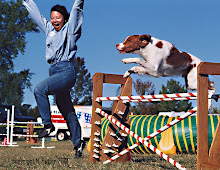[This was originally posted to the Fairmount Animal Hospital web site on 24 November 2008.]
Dear Dr. Lee,
I’ve been told by my veterinarian that my cat is too heavy. Other than limiting calories, is there anything else I can do to keep my cat fit? How do you get a cat to do jumping jacks?
Chubbs in Canastota
Dear Chubbs,
I have yet to see a cat do jumping jacks, but there are ways to increase your cat’s activity level, which can result not only in weight control, but enhance the bond with your cat. Planned sessions of interactive play can also result in a cat willing to rest when you do (and thus less inclined to bother you while you’re sleeping), and may decrease play aggression because your play will be in a controlled manner.
Here are some suggestions for play with your cat:
• Fetch – If your cat does not fetch yet, tie a string to his favorite toy, toss the toy, then reel it back in. Eventually, your cat may start bringing the toy back to you himself because he gets rewarded by another toss of the toy.
• Drag a string or a shoelace around the house. To increase interest, you can tie a knot or attach a folded paper fan. You can drag the string up and down areas that your cat is allowed to climb to increase the intensity of his “work out.”
• Ball – If your cat does not know how to play with one, you may need to help him by pushing it yourself first. This is particularly fun on hard surfaces, like hardwood floors or the bathtub. There are treat balls that you can load with kibble or treats that reward the cat for playing with it – as the cat plays with it, food falls out.
• The recall game – with a friend or family member, have your cat run between the two of you and reward with a small food treat each time the cat runs to you.
• Toss – throw a piece of kibble or a treat down a long hallway for your food-motivated cat.
• Hang a toy from a doorknob or the top of the door frame. Jiggle it to make it more interesting.
• Container game – Use an empty paper bag or cardboard box. Cats are naturally curious about these spaces. When he goes in, scratch the outside of the container with your finger and your cat may try to catch your finger through the container wall.
• Movement – make any toy your cat likes more interesting by making it move.
• Laser pointer – many cats will chase the beam for hours. Do not direct the beam into the eyes of people or animals. Do not use this method of play with dogs, as they can develop obsessive compulsive disorder.
• Hide and seek – pretend to hide. As your cat approaches your hiding spot, “reveal” yourself and pet your cat and tell him how brilliant he is.
• Toy rotation – do not leave all your cats toys out at the same time. Hide them and rotate through them – it adds an aspect of novelty, even if it is a toy he has played with before.
Some additional hints: Do not reward bad behavior by playing with your cat – start a play session when your cat is calm. Do not use body parts as toys (see Play Aggression article). Set aside specific times of day for the play sessions so that your cat knows when to anticipate his fun time.
Sincerely,
Dr. Lee
P.S. Next week, how to choose toys for your cat.
My primary objective is to help pets and owners enjoy a more satisfying relationship with each other and maintaining the pet’s health to maintain the pet’s quality of life. Pets have the ability to enrich our lives immensely, and I feel that owners also have a responsibility to enrich their pets’ lives, too.
Got a pet behavior question?
E-mail me at fah@fairmountanimal.com.
